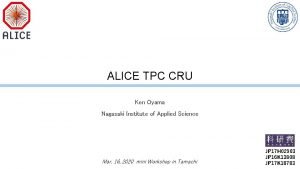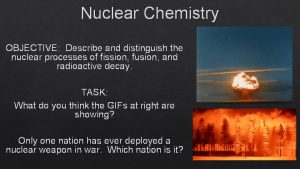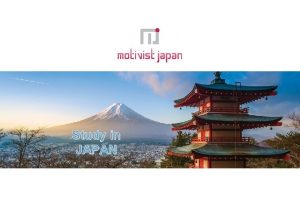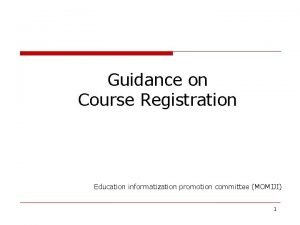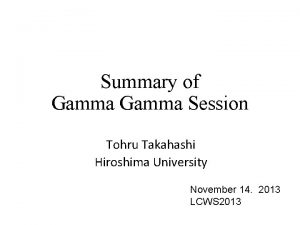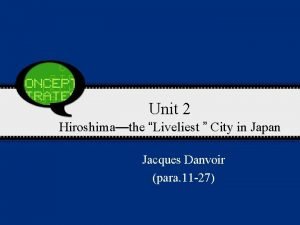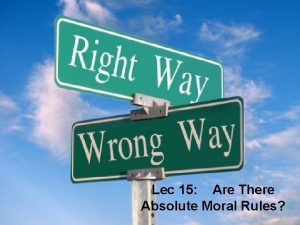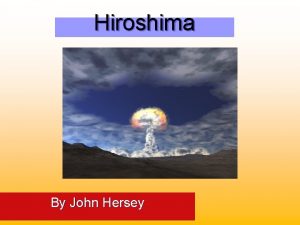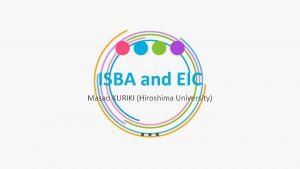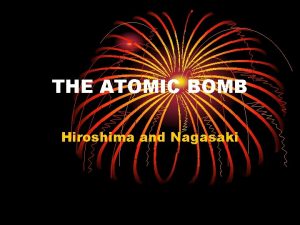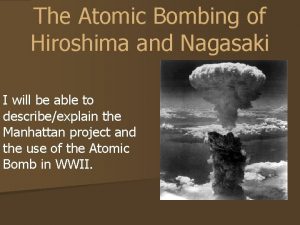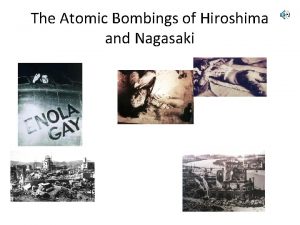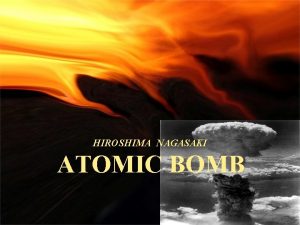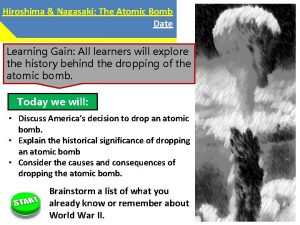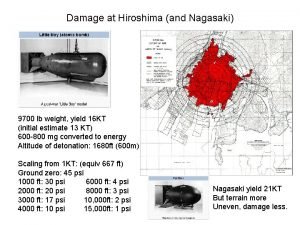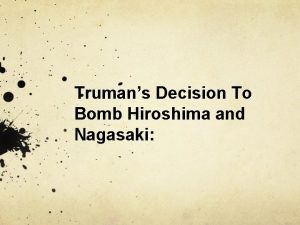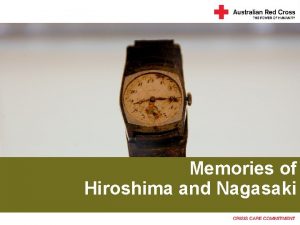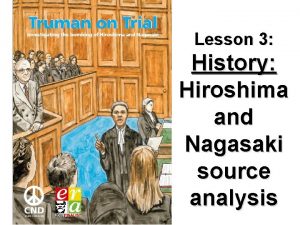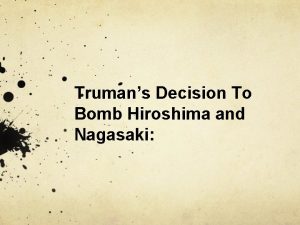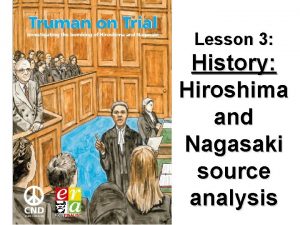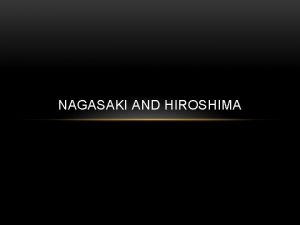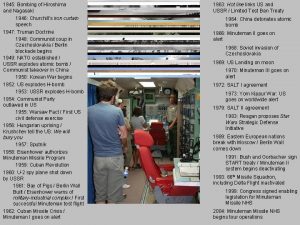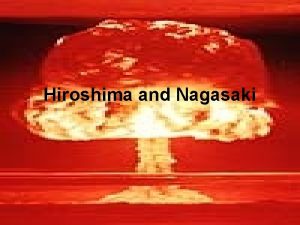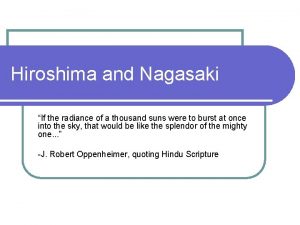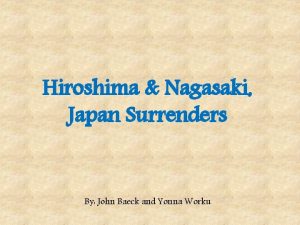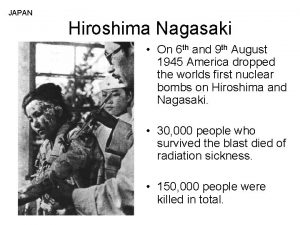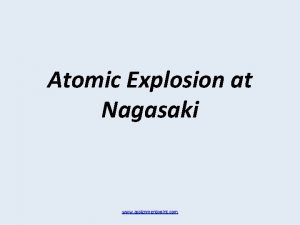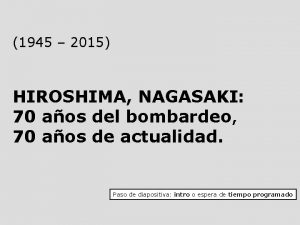Hiroshima and Nagasaki The Effects of the Atomic



































- Slides: 35

Hiroshima and Nagasaki The Effects of the Atomic Bomb and the Debate Note: This Power. Point is largely based upon exhibits found at the Hiroshima Peace Memorial

“My God, What Have We Done” John Lewis, Co-Pilot of the Enola Gay

Japan • The atomic bomb named "Little Boy" was dropped on Hiroshima by the Enola Gay, a Boeing B-29 bomber, at 8: 15 in the morning of August 6, 1945. “Fat Man” was dropped on Nagasaki 3 days later on August, 9, 1945.

Panorama http: //www. pcf. city. hiroshima. jp/frame/ Virtual_e/visit_e/est. Panel_3. html

Hiroshima

Hiroshima Blast The bomb briefly flashed at a height of 580 meters and then erupted into an enormous fireball like the sun. More than a million degrees Celsius at its center, the fireball reached a maximum diameter of 280 meters in one second. Surface temperatures near the hypocenter rose to 3, 000 -4, 000℃. Fierce heat rays and radiation burst out in every direction, expanding the air around the fireball and creating a super-high-pressure blast. The Final death toll is believed to be around 140, 000, mostly civilians. The clothes of the victims were burned by the heat. Bloodstained and in tatters, the survivors fled the devastated city.

Damage to Buildings Eighty-five percent of Hiroshima's buildings were within three kilometers of where the atomic bomb exploded over the heart of the city. The damage extended to virtually the entire city, with 90 percent of all buildings burned or destroyed beyond repair.

Pocket watch 1, 600 m from the hypocenter Kengo Nikawa (then, 59) was exposed to the bomb crossing the Kan-on Bridge by bike going from his home to his assigned building demolition site in the center of the city. He suffered major burns on his right shoulder, back, and head and took refuge in Kochi-mura Saiki-gun. He died on August 22. Kengo was never without this precious watch given him by his son, Kazuo.


Acute Effects The most common acute disorders were epilation, symptoms of damage to mucous membranes including diarrhea, dysentery, melena and bleeding from gums, and impeded blood-forming functions. The acute effects had largely subsided by the end of December, approximately five months after the bombing. Hair combed off of head in 3 strokes of a brush

Radiation The defining characteristic of an atomic bomb that distinguishes it from any conventional bomb is radiation. Those exposed within about 1000 meters of the hypocenter received life-threatening doses, and most died within a few days. Decades later, that radiation was still producing harmful aftereffects. Leukemia and other cancers appeared over the course of 2 to 20 years, and radiation effects still threaten the health of the survivors.

Black Rain Soon after the explosion, a giant mushroom cloud billowed upward, carrying dirt, dust, and other debris high into the air. After the explosion, soot generated by the conflagration was carried by hot air high into the sky. this dust and soot became radioactive, mixed with water vapor in the air, then fell back to earth in what came to be called "black rain. “ The black rain contained radioactive material. Fish died and floated to the surface in the ponds and rivers where this rain fell. Many of the people who drank from wells in areas where the black rain fell suffered from diarrhea for three months.

Keloids Scars left by exposure to heat and radiation erupted 2 -3 years after the blast

Cataracts The patient was exposed 820 m from the hypocenter and had white cloudiness in both eyes. The dark area in the center of this photo is the cloudiness caused by an A-bomb cataract. Cataracts occurred several months to several years after exposure.

Leukemia and Cancer Leukemia is cancer of the blood. The white blood cells multiply wildly without fully maturing. Red blood cells and platelets are reduced, leading to anemia. The white blood cells increase in number but lose normal functioning, which lowers resistance to infection. The incidence of leukemia was greatest 7 to 8 years after the bombing. The younger the survivor was at the time of exposure, the earlier was the onset of leukemia. Cancers began to increase about 1960. Some cancers for which a correspondence has been confirmed between distance from the incidence are: myeloma, ovary cancer, urinary tract cancer, breast cancer, colon cancer, lung cancer, esophagus cancer, stomach cancer

Birth Defects Radiation harmed fetuses in various ways. Some were stillborn. Some children were born without obvious problems but had higher mortality rates, even those who lived past infancy. Development tended to be slower than that of other children. Some were born with abnormally small heads, a condition known as microcephaly. Those who were exposed close to the hypocenter in early pregnancy were likely to display microcephaly accompanied by severe mental retardation that renders them unable to manage everyday life without assistance.

Blast The atomic explosion created a super-high pressure at the epicenter of several hundred thousand atmospheres. The surrounding air expanded enormously, creating a tremendous blast. All wooden houses were destroyed within a radius of two kilometers from the hypocenter. Even ferro-concrete structures were crushed by the power of the blast. Windows were smashed at a distance of sixteen kilometers.

The Blast Pressure The wind velocity on the ground beneath the explosion center was 980 miles/hr, which is five times stronger than the wind generated by strong hurricanes

Heat Within 0. 3 seconds of detonation, the fireball high in the air grew to a diameter of more than 200 meters. The temperature on the surface was 7, 000 degrees C. The heat rays released by that fireball devastated the people and things below.

Human Shadow Etched in Stone A person sitting on the bank steps waiting for it to open was exposed to the flash from the atomic bomb explosion. Receiving the rays directly from the front, the victim undoubtedly died on the spot from massive burns. The surface of the surrounding stone steps was turned whitish by the intense heat rays. The place where the person was sitting remained dark like a shadow

Pictures

Fire When the atomic bomb detonated, houses at or near the hypocenter ignited all at once. Flames leapt up quickly throughout the city. For the next 3 days, the city burned. Within a radius of two kilometers, all combustible material was burned and the thousands of people trapped under collapsed buildings were burned to death.

Relief The atomic bomb instantaneously destroyed the Prefectural government offices, City Hall, the police stations, and all government buildings. The next day, the Army Marine Headquarters (commonly known as the Akatsuki Corps), which sustained only slight damage, took the lead in establishing the Hiroshima Security Regiment Headquarters. The military, the government, and the people united to carry out relief activities, often with little understanding of the effects of radiation.

War orphans and Discrimination Thousands of war orphans were created by the bomb. Survivors of the bomb were victims of discrimination after the war. Known as Hibakusha, they found it difficult to find spouses to marry, get into good schools and colleges, and get hired for decent jobs. Listen at http: //www. atomicarchive. com/Docs/Hibakusha_i ndex. shtml

Jimmy Carter in Hiroshima This memorial must be a constant and permanent reminder for all people to work for peace and better understanding.

The Dalai Lama • As humans, we all have the duty to eliminate, from this earth, weapons with destructive capacity beyond expression and conception. Please, every one of you, use all of your power to accomplish this duty. A Tibetan Shakya Bhikshu (Signature) March 30, 1995

Poems and Testimonials The following verse is from "Flower of Summer" (Natsu no Hana), a collection of short stories by Tamiki Hara (1905 -1951), writer and A-bomb survivor. This is a human being? Look how the atom bomb changed it. Flesh swells fearfully. All men and women lake one shape. The voice that trickles from swollen lips on the festering, charred-black face whispers the thin words, "Please help me. " This, this is a human being. This is the face of a human being.

Sadako and the Thousand Cranes Sadako was a young, Japanese girl who was 2 years old when the bomb struck Hiroshima. At 11 years old, she developed Leukemia. In an effort to influence the gods to help her survive, she folded 1, 000 paper cranes. She died at 12 years old. Sadako represents all of the children who died in Hiroshima, and the paper crane has become an international symbol of peace.

Hiroshima Today

Manhattan Project The Manhattan Project is the code name for the secret US program to develop a nuclear bomb during WWII. The genesis of the project was Albert Einstein’s 1939 letter to FDR in which he suggested that an atomic bomb could be built. In 1942 Enrico Fermi, a physicist, successfully controlled the first nuclear reaction in his reactor. The first nuclear test took place on July 6, 1945 in Los Alamos, New Mexico.

J. Robert Oppenheimer, Director of the Manhattan Project “We knew the world would not be the same. A few people laughed, a few people cried, most people were silent. I remembered the line from the Hindu scripture, the Bhagavad. Gita. Vishnu is trying to persuade the Prince that he should do his duty and to impress him takes on his multiarmed form and says, ‘Now, I am become Death, the destroyer of worlds. ’ I suppose we all felt that one way or another. ”

Arguments for Dropping the Atomic Bomb Save (1, 000? ) American and Japanese lives. Japanese resisted US forces by use of Kamikaze pilots in Okinawa and fighting without surrender at Iwo Jima and other battles. They didn’t surrender after the fire bombing of major cities. No worse than fire bombing those cities. End the war quickly. The US was tired after 4 years of war. Germany had already surrendered in May, 1945. Japan resisted an unconditional surrender. End the war before the Soviets join the Pacific war. The USSR had promised to join the war in August 1945. Demonstrate US power to the world. Convince the world that these weapons should be abolished. Racism. US policy makers expressed racist attitudes toward Japanese Revenge. Truman suggested after the war that he wanted to exact revenge for Pearl Harbor. Large resources went into the development of the atomic bomb, and there was a desire to use it and test it. As an unelected President, Truman was controlled by his close advisors who favored using the bomb. Scientists and policy makers didn’t fully appreciate effects of the bomb. With only 2 bombs, it would have been wasteful to detonate one as a demonstration. It might even be embarrassing if it didn’t go off.

Arguments Against Dropping the Bomb Moral failure for being the only country to use an atomic bomb in war. The attack struck mainly civilians who outnumbered military personnel 6: 1. When Truman announced the attack, he falsely claimed that Hiroshima was “a military base. ” Japan was ready to surrender anyway. It was blockaded. Its navy and air force was destroyed. It’s overseas possessions were confiscated. The US needlessly insisted upon an unconditional surrender, since Japan was willing to surrender if it could retain the Emperor. A demonstration of US power would have been sufficient US moral authority, nationally and internationally, was weakened. Contributed to mistrust held by the USSR and prompted a dangerous arms race. There was no need for the second bomb on Nagasaki. There were many prominent military personnel against dropping the bomb, like Eisenhower, under-Secretary of the Navy, Ralph Bard, Army Chief of Staff General George C. Marshall, and Admiral Chester W. Nimitz, Commander in Chief of the Pacific Fleet.

Websites and Sources • • • • http: //www. colorado. edu/Am. Studies/lewis/2010/atomic. htm http: //www. trumanlibrary. org/whistlestop/study_collections/bomb/large/bomb. htm ; http: //www. trumanlibrary. org/whistlestop/study_collections/bomb/small. htm Primary documents from the Truman Library http: //www. pcf. city. hiroshima. jp/peacesite/index. E. html Hiroshima Peace Memorial Museum: http: //www 1. city. nagasaki. jp/na-bomb/museume 01. html Nagasaki Atomic Bomb Museum: http: //hnn. us/articles/190. html The trial of Harry Truman http: //www. dannen. com/decision/index. html Full text documents on the dropping of the atomic bomb http: //www. vw. cc. va. us/vwhansd/HIS 122/Hiroshima. html Article by David Hansen on the decision to drop the bomb http: //sun. menloschool. org/~sportman/ethics/project/topics/hiroshima/index. html Student website that outlines the pro and con of the bombing of Hiroshima and Nagasaki http: //wgordon. web. wesleyan. edu/papers/hiroshim. htm Argument against the dropping of the bomb by Bill Gordon, a masters student at Wesleyan University http: //encarta. msn. com/encyclopedia_761557001_4/Harry_Truman. html Encarta entry on Harry Truman http: //www. csi. ad. jp/ABOMB/index. html The A-Bomb www museum http: //www. grolier. com/wwii_mainpage. html Links to WWII sites http: //www. japan-guide. com/e/e 2125. html Links to A-Bomb sites http: //www. nuclearfiles. org/ Documents and sites from The Nuclear Age Peace Foundation. http: //www. doug-long. com/marshall. htm General George Marshall's argument for dropping the bomb

The End
 Nagasaki location
Nagasaki location Nagasaki sorting algorithm
Nagasaki sorting algorithm Hiroshima shadow
Hiroshima shadow Relative formula mass of hcl
Relative formula mass of hcl O
O Whats the difference between atomic mass and atomic number
Whats the difference between atomic mass and atomic number Human academy japanese language school fees
Human academy japanese language school fees Hirodai momiji
Hirodai momiji Tohru hiroshima
Tohru hiroshima Jacques danvoir
Jacques danvoir Micron fab6
Micron fab6 Hiroshima
Hiroshima Hiroshima
Hiroshima Hiroshima
Hiroshima периодический закон
периодический закон Atomic radius periodic trend
Atomic radius periodic trend Atomic number vs atomic radius
Atomic number vs atomic radius Hát kết hợp bộ gõ cơ thể
Hát kết hợp bộ gõ cơ thể Slidetodoc
Slidetodoc Bổ thể
Bổ thể Tỉ lệ cơ thể trẻ em
Tỉ lệ cơ thể trẻ em Gấu đi như thế nào
Gấu đi như thế nào Chụp tư thế worms-breton
Chụp tư thế worms-breton Chúa yêu trần thế
Chúa yêu trần thế Các môn thể thao bắt đầu bằng tiếng đua
Các môn thể thao bắt đầu bằng tiếng đua Thế nào là hệ số cao nhất
Thế nào là hệ số cao nhất Các châu lục và đại dương trên thế giới
Các châu lục và đại dương trên thế giới Công thức tính thế năng
Công thức tính thế năng Trời xanh đây là của chúng ta thể thơ
Trời xanh đây là của chúng ta thể thơ Mật thư anh em như thể tay chân
Mật thư anh em như thể tay chân Phép trừ bù
Phép trừ bù Phản ứng thế ankan
Phản ứng thế ankan Các châu lục và đại dương trên thế giới
Các châu lục và đại dương trên thế giới Thể thơ truyền thống
Thể thơ truyền thống Quá trình desamine hóa có thể tạo ra
Quá trình desamine hóa có thể tạo ra Một số thể thơ truyền thống
Một số thể thơ truyền thống

